08
2025
-
06
Unraveling the Magic of Fiber Optic Splitters in the Tech Industry
The Backbone of Modern Connectivity
Have you ever wondered how information travels at lightning speed across the globe? Well, let me tell you, it’s all thanks to fiber optic technology! And at the heart of this high-speed revolution lies a little device known as the Fiber Optic Splitter. This nifty gadget is the unsung hero of the telecommunication industry, enabling seamless data transmission and connectivity.
What Is a Fiber Optic Splitter?
Simply put, a Fiber Optic Splitter is a device that divides a single optical signal into multiple signals. Think of it as a traffic cop at a busy intersection, directing data where it needs to go without causing a jam. This makes it essential for both residential and commercial applications, allowing multiple users to share a single fiber optic line.
Real-World Applications: Where the Magic Happens
Now, let’s dive into some industry cases where fiber optic splitters are making waves. Spoiler alert: they’re everywhere!
1. Telecommunications
In the telecommunications sector, fiber optic splitters are a game-changer. They’re used in fiber-to-the-home (FTTH) deployments, allowing ISPs to serve multiple households through a single line. This not only enhances efficiency but also reduces costs. Can you imagine the savings? It’s a win-win!
2. Data Centers
Data centers are the beating heart of the internet, and they require robust infrastructure to manage vast amounts of data. Fiber optic splitters facilitate effective data distribution, ensuring that resources are allocated efficiently without bottlenecks. When a data center runs smoothly, everything else falls into place—like a well-oiled machine!
3. Smart Cities
As cities become smarter, the demand for reliable connectivity skyrockets. Fiber optic splitters are crucial for supporting various smart initiatives, from traffic management systems to public safety networks. They help create a connected ecosystem that improves urban living. Who wouldn’t want that?
The Technical Side: How Does It Work?
If you’re a tech enthusiast, you might be curious about the inner workings of a Fiber Optic Splitter. These devices typically use a method called passive optical splitting, which means they don’t require electrical power to operate. They split light signals using a combination of optical fibers and specialized components. It’s like magic, but definitely grounded in science!
Challenges and Considerations
Of course, no technology is without its challenges. Fiber optic splitters can experience signal loss, which can affect performance. However, advancements in technology are continually improving efficiency, making these devices more reliable than ever. Plus, proper installation and maintenance can mitigate many issues. It’s all about staying ahead of the curve!
The Future is Bright
As we look to the future, the role of Fiber Optic Splitters will only grow. With the rise of 5G technology and the increasing need for faster internet speeds, these devices will become even more crucial in the global communications infrastructure. So, buckle up; it’s going to be an exciting ride!
Final Thoughts
To sum it all up, fiber optic splitters are a pivotal component of modern connectivity, transforming the way we communicate and interact with the world. Whether in telecommunications, data centers, or smart cities, these devices are paving the way for a connected future. Next time you enjoy a fast internet connection, remember the little device that made it all possible—the Fiber Optic Splitter!
Relevant news
CONTACT US
Add: No.1 Yonghe Third Road, Industrial Functional Zone, Chengdong Street, Yueqing City, Wenzhou City, Zhejiang Province
Tel: +86-577-62315998
Wechat : +86-15067871794
Fax: +86-577-62328331
E-mail: bonnie.chen@ouyahua.com











